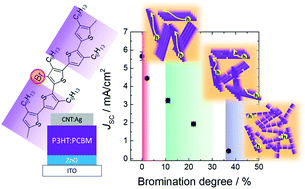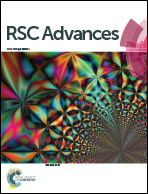Effects of bromination of poly(3-hexylthiophene) on the performance of bulk heterojunction solar cells†
Abstract
We examined the effects of delocalized π-electrons in poly(3-hexylthiophene) (P3HT) on the photovoltaic properties of a bulk heterojunction (BHJ) solar cell. The π-conjugated length of P3HT was controlled by modification of P3HT through partial bromination at the 4-position of thiophene units. We investigated correlation between the degree of P3HT bromination (2, 11, 22, 37, 66, 84, 100%) and the photovoltaic properties of Br-P3HT:phenyl-C61-butyric acid methyl ester (PCBM) BHJ solar cells. The power conversion efficiency of the 11% Br-P3HT:PCBM solar cell decreased to 56% of that of a pristine P3HT:PCBM solar cell. The main factor contributing to this decrease was lower short circuit currents. The photo absorption spectrum and the X-ray diffraction pattern of the 11% Br-P3HT film showed only slight differences to those of pristine P3HT, indicating the interchain π-stacking of the polymers was almost unaffected by the 11% bromination. These results suggest that an intrachain π-conjugation across more than 10 thiophene rings in the P3HT backbone is necessary to realize efficient charge transport in polymer domains. The 37% Br-P3HT:PCBM cell showed only weak photovoltaic properties; both inter- and intrachain delocalization of π-electrons were disturbed by bromination.



 Please wait while we load your content...
Please wait while we load your content...